![]()
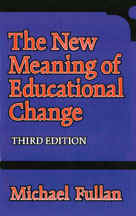 The
New Meaning of Educational Change, Third Edition The
New Meaning of Educational Change, Third EditionBy Michael Fullan Reviewed by By Rick Chambers Michael Fullan, dean of education at the Ontario Institute for Studies in Education of the University of Toronto, has been talking and writing about change and change processes for more than 20 years. Fortunately for him, the field of education has been rife with examples to study. His latest book on change, The New Meaning of Educational Change, Third Edition, begins with a primer on educational change – its history, sources, meaning, causes, implementation strategies and plans. Fullan then goes on to focus on educational change as it affects everyone in the system, from students and teachers to district administrators and governments. As a widely known consultant on change, Fullan uses his research and experience in the United States, the United Kingdom and Canada to put the Ontario situation in context. "Neglect of the phenomenology of change – that is, how people actually experience change as distinct from how it might have been intended – is at the heart of the spectacular lack of success of most social reforms," he writes. Fullan avoids finger pointing and instead empathizes with those struggling with educational change at every level. Teachers on the front line have to understand the need for the change and the strategies for its implementation. Speaking globally, he says, "Teaching needs to become a highly intellectual as well as a highly caring profession. Because it takes place under intense social and political circumstances it is also a profession that demands great emotional intelligence. The question is, can the profession become that good?" As for governments, he is "willing to conclude that the combination of account-ability and incentives produces results. The question is at what price? And are they substantial, lasting results?" Fullan’s research indicates that having a solution and making it work are vastly different. He suggests that top-down change is ineffective and bottom-up change is short-lived. The best change initiatives appear to be the ones that embrace all the stakeholders collaboratively. He says, "Every time a school district has been working diligently on a problem and they ask us to help them go further, it almost always helps. Every time a district is experiencing a problem and they ask us to provide the solution, it never works." The critical shortage of teachers is putting pressure on faculties of education. At the same time, American research indicates that three good teachers in a row can determine the success of a student’s school career. As a result, "new and nervous attention" is being paid to teacher education reform. But as Fullan says, without the integration of teacher education reform with other areas of educational change – like how to hire and support beginning teachers – changing teacher education will not produce the necessary improvements. Unfortunately, there is no silver bullet for educational change. Reformers may have great ideas but without implementation strategies and co-operation at every level of the system, real educational change remains elusive. The New Meaning of Educational Change puts the whole process in perspective. The New Meaning of Educational Change, third edition. Toronto: Irwin Publishing Ltd., 2001. ISBN: 0-8077-4069-1; softcover, 272 pages, $39.95; phone: 416-798-0424; toll-free: 1-800-263-7824; fax: 416-798-1384; e-mail: unicoll@irwinpublishing.com Rick Chambers is a program officer in the College’s Professional Affairs Department.
Reviewed by Elizabeth M. Starr Hurrah! This perceptive, readable and practical book demystifies some of the reasons why students with autism and other disabilities use aggressive, self-injurious or otherwise disruptive behaviour in the classroom. The book suggests how to use visual strategies to ameliorate or even extinguish such behaviour. Hodgdon begins by providing a context for understanding behaviour difficulties and stresses how crucial it is to understand the underlying causes, or the function that behaviour serves. She goes on to discuss why limited communication skills are often the cause for disruptive behaviour. All of this is done with many examples. Then, Hodgdon concentrates on how the use of visual strategies to support communication can solve many behaviour problems. She includes dos and don’ts for creating and using visual strategies. This book is a must for every school’s resource library. Solving Behavior Problems in Autism: Improving Communication with Visual Strategies. Troy, Michigan; QuirkRoberts Publishing, 1999. ISBN: 0-9616786-2-3; softcover, 254 pages, US$39.95; phone: 248-879-2598; fax: 248-879-2599: e-mail: quirkrobertspublishing@home.com Elizabeth Starr is a member of the Ontario College of Teachers and an associate professor at the faculty of education, University of Windsor, specializing in autism research.
Ladders to Learning is a Canadian company that creates imaginative reading activity kits for children aged four to seven. Each kit contains a copy of a delightful children’s story and activities and games to be explored with an adult. Puzzles and arts and craft activities are stimulating and fun, providing children with an early opportunity to experience problem-solving and play-based learning. Colourful and enchanting books introduce rhyming and poetry. Guided play with games that use numbers, dots on a die and markers fosters an understanding of early mathematical computation. Each of the six kits contains the supplies for a variety of activities that promote an appreciation of the wonder of science, literature and art. Ladders to Learning kits foster skills that encourage a successful start in school. The only caution is the many small pieces in the kits – inevitably, pieces will stray. 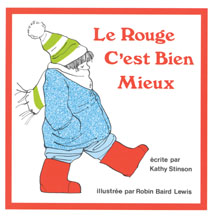 Reviewed
by Helen Donohoe (French version) Reviewed
by Helen Donohoe (French version)Le Rouge C'est Bien Mieux is the French version of the attractively packaged kits available in the Ladders to Learning series. The text is supple-mented by a well-planned collection of activities – felt cutouts, game board, game pieces made of high quality materials. A teacher’s guide provides additional ideas for modifying or extending the language and the concepts. The kit includes a checklist that matches the Ontario curriculum to the text and its related activities. The high quality and the comprehensive nature of this learning kit make it ideal for Kinder-garten and Grade 1 French immersion classes and the library in a French immersion school. It would also make a fine gift for a primary immersion student. Ladders to Learning Almonte, ON, 2001; $29.95 per kit; toll-free: 1-877-331-4449; fax: 613-256-2380; www.ladders_tolearning.com
Reviewed by Rick Chambers The exclamation point in the title of Michael Gurian’s new book suggests either that he was surprised at what he discovered or that we should be. Gurian begins with the current state of brain-based and gender-based research. The language, terms and charts prepare the reader for the rest of the book – what all this research tells us about how we should teach children from preschool to high school. The research seems to confirm much of what teachers know: small classes promote greater learning; consistent and even strict discipline practices promote healthy learning environments; zero-tolerance policies are easier to support in small private schools. Gurian challenges conventional wisdom on several fronts. He suggests computer use before Grade 4 is unnecessary and repeatedly recommends same-sex classes for children from elementary to high school. The summary of current research on brain-based and gender-based learning and its application in classrooms suggest many practical strategies for teachers new to the profession. For experienced teachers, the book provides some surprising arguments. Boys and Girls Learn Differently!: San Francisco: Jossey Bass/John Wiley & Sons, 2001. ISBN: 0-7879-5343-1; hardcover, 314 pages, $36.95; phone: 416-236-4422; fax 416-236-4448; www.wiley.com Rick Chambers is a program officer in the College’s Professional Affairs Department. 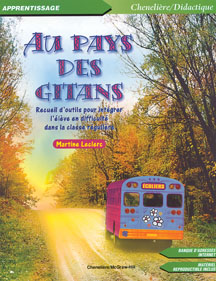 Au pays des gitans
Au pays des gitans(in French) By Martine Leclerc Reviewed by Lise Presseault
Lise Presseault is a senior program officer in the Standards of Practice and Education unit at the College. La collection Coup d’oeil French version of the All About series By Barb McDermott and Gail McKeowan Reviewed by Hélène Beauchesne Learn all about Canada with Baluchon the Beaver. This is what the Coup d’œil collection invites us to do, with a set of booklets about various features of Canada. The collection is designed for students from Junior Kindergarten to Grade 3. Teachers in both French-language and immersion schools now have a high-quality, multi-purpose teaching tool. The Coup d’œil collection is divided into nine sections or topics of six to 14 booklets. The authors present the following topics: animals, capital cities, provinces and territories, famous people, attractions, regions, sports, symbols and inventors. Each booklet is about 30 pages and has simple text and appealing photographs and maps that encourage children to pursue their discussion. In each booklet, Baluchon, the beaver mascot, prompts the children to use various learning skills. Every elementary-school teacher should have this collection. La collection Coup d’oeil. Montréal: Chenelière/McGraw Hill, 2001. $36.95 to $75.95 per section; phone: 514-273-8055; toll-free: 1-800-565-5531; fax: 514-273-0324; e-mail: chene@dlcmcgrawhill.ca Hélène Beauchesne is a French Immersion teacher, currently on leave in Ohio. 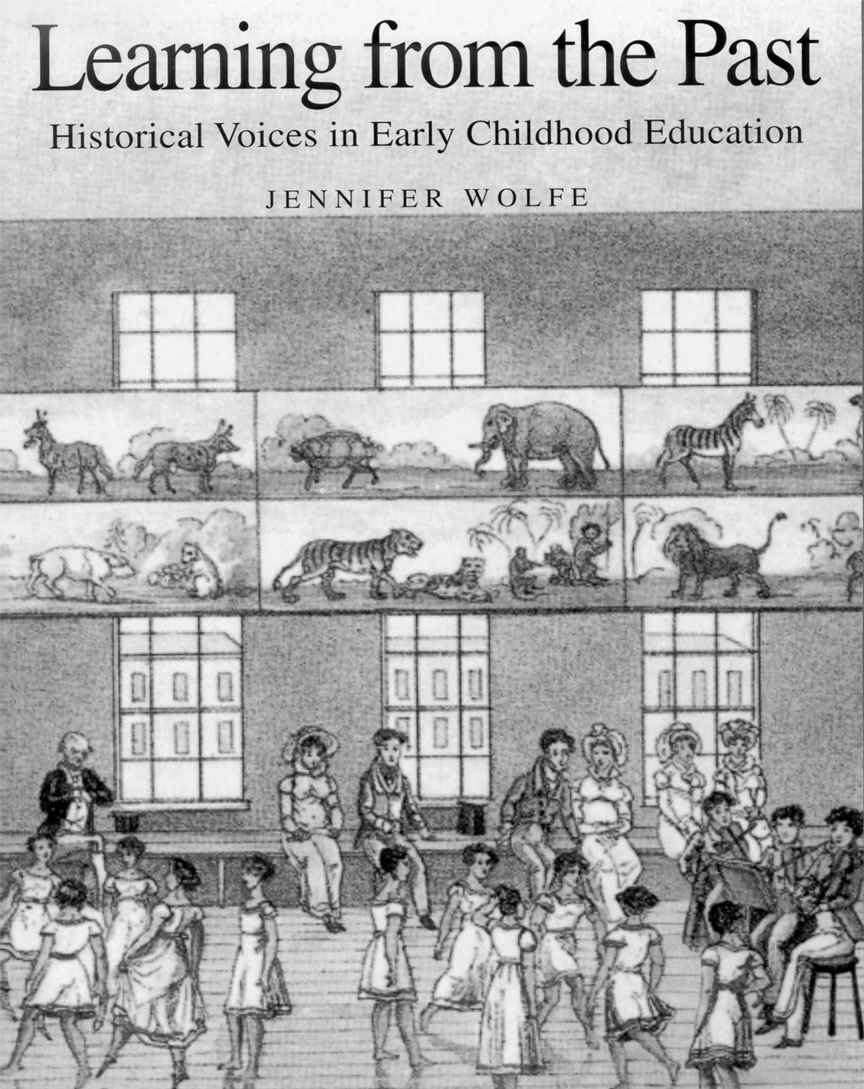 Learning
from the Past: Historical Voices in Learning
from the Past: Historical Voices in Early Childhood Education By Jennifer Wolfe Reviewed by Katherine Wainman For anyone looking for information on the underpinnings of early childhood education, Jennifer Wolfe’s Learning from the Past: Historical Voices in Early Childhood Education is an excellent place to start. Beginning with Plato, Wolfe examines early childhood education through 11 historical figures, ending with Lucy Sprague Mitchell in the 1900s. Each chapter provides a detailed description of a particular era. Background information about each educator emphasizes their work in early childhood education. Illustrations, thought-provoking questions and available resources are included. Learning from the Past: Historical Voices in Early Childhood Education. Mayerthorpe, Alberta; Piney Branch Press, 2000. ISBN: 0-9685849-0-X; softcover, 404 pages, $44.95; phone: 780-786-4459; e-mail: jwolfe@telusplanet.net Katherine Wainman is a teacher-librarian at J.D. Hogarth Public School in Fergus. 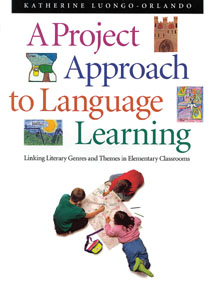 A Project Approach to Language Learning
A Project Approach to Language LearningBy Katherine Luongo-Orlando Reviewed by Caroline This valuable resource for teachers in the late Primary to Intermediate grades shows how to engage students in projects that introduce them to a variety of literary genres and themes. The step-by-step approach to each project makes the activities manageable for teachers and students alike. The instructional strategies suggested can also be modified for learners at different levels. Student work samples are provided and blackline masters are available throughout the book. Rubrics and checklists, professional references and children’s literature, categorized by genre and theme, are provided at the back of the book. Helpful hints are listed in the margins. A Project Approach to Language Learning. Markham; Pembroke Publishers, 2001. ISBN: 1-55138-128-1; softcover, 160 pages, $18.95; phone: 905-477-0650; toll-free: 1-800-997-9807; fax: 905-477-3691; www.pembrokepublishers.com Caroline Cremer teaches Grades 1 and 2 at Leslieville Junior Public School in Toronto 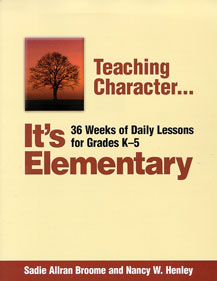 Teaching Character:
It’s Elementary
Teaching Character:
It’s ElementaryBy Sadie Allran Broome and Nancy W. Henley Reviewed by Tim Singh Experienced teachers Broom and Henley maintain that teaching character traits to our students is just as important as teaching the academic curriculum. They present the case that by developing character in students, teachers can provide an environment that is conducive to more effective learning and that by helping students develop high self-esteem they will also help them to realize their potential. Teaching Character: It’s Elementary. Chapel Hill, North Carolina: Character Development Publishing, 2000. ISBN: 1-892056-08-9; softcover, US $27.95; phone: 919-967-2110; fax: 919-967-2139; e-mail: respect96@aol.com Tim Singh teaches Grade 5/6 at St. Therese of the Child Jesus School, Dufferin-Peel Catholic District School Board. 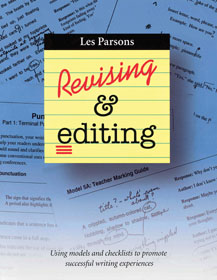 Revising and Editing
Revising and EditingBy Les Parsons Reviewed by Mary Jane Kearns-Padgett Revising and Editing is for teachers interested in experimenting with models and checklists as a means of promoting students’ successful revision of their own writing. The book uses eight modelling series for essays, poems, projects and prose writing. This text presents an approach worth examining insofar as it reminds students that revising and editing should be more than cleaning up the mechanics. Revising and Editing. Markham, Pembroke Publishers, 2001. ISBN: 1-55138-130-1; softcover, 128 pages, $18.95; phone: 905-477-0650; toll-free: 1-800-997-9807; fax: 905-477-3691; www.pembrokepublishers.com Mary Jane Kearns-Padgett teaches at Hillfield Strathallan College in Hamilton. 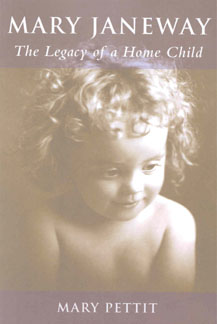 Mary Janeway: The Legacy of a Home Child
Mary Janeway: The Legacy of a Home ChildBy Mary Pettit Reviewed by Brenda Dillon Born in Scotland in 1884 or 1885, the fourth of five children, Mary Janeway and her siblings were sent to a children’s home in London on her mother’s death. This home, like a number of others, sent orphaned or destitute children to Canada. Although intentions were good, the reality for many home children was a life of overwork, hunger and abuse. Mary ended up on an Innerkip farm. Any child past the age of five was considered old enough to earn their keep, and Mary, aged seven, became a domestic for the farm family. This biography, written by Janeway’s goddaughter, could be read by a teacher or by students (Grades 6-7). If used with Kenneth Bagnell’s The LittleImmigrants: The Orphans Who Came to Canada, it could provide a valuable resource for the study of 19th century rural Ontario or the history of immigration. Mary Janeway: The Legacy of a Home Child. Toronto; Natural Heritage/Natural History Inc, 2000. ISBN: 1-896219-69-1; paperback, 176 pages, $19.95; phone: 416-694-9707, toll-free: 1-800-725-9982; fax: 416-690-0819; e-mail: natherbooks@idirect.com Brenda Dillon is the teacher-librarian at Philip Pocock Catholic Secondary School, Dufferin-Peel Catholic District School Board.  Nunavut
Territory Nunavut
TerritoryCD-ROM Central Arctic Services Reviewed by Christopher Ball This newly updated resource is sure to captivate students of all ages. The Nunavut CD is affordable, easy to navigate and runs on a wide variety of hardware. It even includes a pre-installed video player. Through photos, maps, files, sound and video clips this resource explores Inuit life and culture, the history of Nunavut, and its wildlife and geography. More than just a collection of pictures and comments, this resource is rich in solid content and the perspective of someone who has lived in the community for nearly a decade. Nunavut Territory CD-ROM. Edmonton: Central Arctic Services Ltd, 2001. $134.28 including taxes; toll-free: 1–888–223–3449; fax: 780-432-6688; e-mail: nunavut@huskydog.com Christopher Ball manages the College’s Library and Archival Services. |
|
From the Chair | Registrar's Report | Remarkable Teachers | Blue Pages News | Reviews | Calendar | Netwatch | FAQ | Letters to the Editor Ontario College of Teachers 121 Bloor Street East, 6th Floor Toronto ON M4W 3M5 Phone: 416-961-8800 Toll-free: 1-888-534-2222 Fax: 416-961-8822 http://www.oct.ca info@oct.ca |